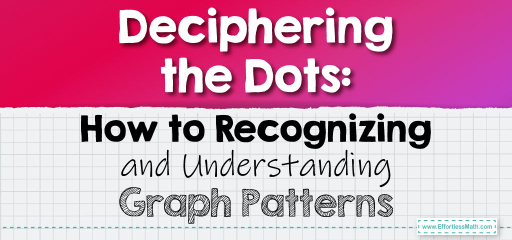Deciphering the Dots: How to Recognizing and Understanding Graph Patterns
Graphs are powerful tools for visualizing data and relationships. Often, the data plotted on a graph will follow a particular pattern or trend.

Recognizing these patterns can provide insights into the underlying phenomena and help in making predictions. In this guide, we’ll explore common patterns seen in graphs and how to interpret them.
Step-by-step Guide to Recognizing and Understanding Graph Patterns:
1. Linear Patterns:
A straight line on a graph indicates a linear relationship between the variables. The slope of the line can tell you the rate of change.
– Rising Line: Indicates a positive relationship; as one variable increases, the other does too.
– Falling Line: Indicates a negative relationship; as one variable increases, the other decreases.
2. Curved Patterns:
Curves can represent various types of relationships:
– U-shaped (Parabolic): This could indicate a quadratic relationship.
– Exponential Growth: A curve that rises sharply indicates that something is increasing at an increasing rate.
– Exponential Decay: A curve that falls sharply indicates a rapid decrease.
3. Oscillating Patterns:
A wave-like pattern indicates periodic or cyclical behavior. This is common in data related to seasons, time cycles, or repeated events.
4. Scatter Plots with No Clear Pattern:
If the points on a scatter plot seem randomly distributed with no discernible trend, it indicates that there might be no correlation between the variables.
5. Clusters:
Groups of data points clustered together can indicate specific categories or groups within the data.
6. Gaps or Outliers:
A point or points that lie far away from the general trend are called outliers. They can be due to anomalies, errors, or genuinely exceptional cases.
7. Plateaus:
A flat section on a graph indicates that a variable has stabilized and is not currently changing.
Example 1:
A graph showing the growth of a bacterial culture over time might start flat (lag phase), then curve upwards sharply (exponential growth phase), and finally plateau (stationary phase).
The Absolute Best Book for 5th Grade Students
Example 2:
A graph plotting daily temperatures over a year would show an oscillating pattern, with temperatures rising in the summer months and falling in the winter.
Practice Questions:
1. If a graph shows the amount of money saved over time and it forms a straight line going up, what does this indicate?
2. A company plots its sales over a year, and the graph shows a U-shaped curve. What might this suggest about their sales?
A Perfect Book for Grade 5 Math Word Problems!

Answers:
1. The person is saving money at a constant rate.
2. The company might have had low sales at the beginning and end of the year but saw a significant increase in the middle of the year.
The Best Math Books for Elementary Students
Related to This Article
More math articles
- Unraveling the Art of Graphing: A Deep Dive into Absolute Value Functions
- The Ultimate TSI Math Formula Cheat Sheet
- Estimating Products
- How to Graph Quadratic Functions?
- How to Find Constant of Proportionality?
- How to Calculate the Surface Area of Pyramids and Cones
- How to Solve Equations with Multiple Angles
- The Ultimate AFOQT Math Formula Cheat Sheet
- 10 Most Common AFOQT Math Questions
- The Ultimate 7th Grade K-PREP Math Course (+FREE Worksheets)





















What people say about "Deciphering the Dots: How to Recognizing and Understanding Graph Patterns - Effortless Math: We Help Students Learn to LOVE Mathematics"?
No one replied yet.